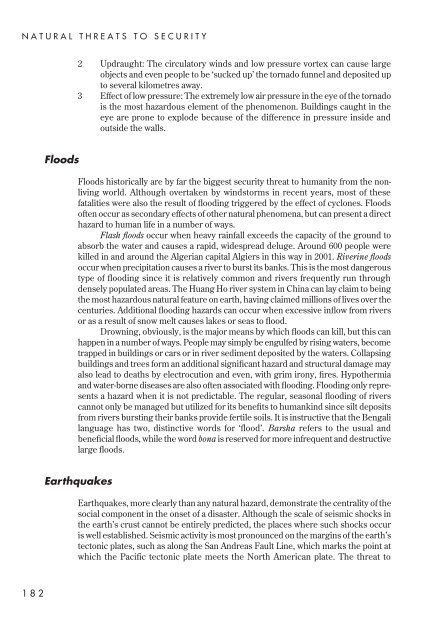Understanding global security - Peter Hough
Understanding global security - Peter Hough
Understanding global security - Peter Hough
Create successful ePaper yourself
Turn your PDF publications into a flip-book with our unique Google optimized e-Paper software.
NATURAL THREATS TO SECURITY<br />
2 Updraught: The circulatory winds and low pressure vortex can cause large<br />
objects and even people to be ‘sucked up’ the tornado funnel and deposited up<br />
to several kilometres away.<br />
3 Effect of low pressure: The extremely low air pressure in the eye of the tornado<br />
is the most hazardous element of the phenomenon. Buildings caught in the<br />
eye are prone to explode because of the difference in pressure inside and<br />
outside the walls.<br />
Floods<br />
Floods historically are by far the biggest <strong>security</strong> threat to humanity from the nonliving<br />
world. Although overtaken by windstorms in recent years, most of these<br />
fatalities were also the result of flooding triggered by the effect of cyclones. Floods<br />
often occur as secondary effects of other natural phenomena, but can present a direct<br />
hazard to human life in a number of ways.<br />
Flash floods occur when heavy rainfall exceeds the capacity of the ground to<br />
absorb the water and causes a rapid, widespread deluge. Around 600 people were<br />
killed in and around the Algerian capital Algiers in this way in 2001. Riverine floods<br />
occur when precipitation causes a river to burst its banks. This is the most dangerous<br />
type of flooding since it is relatively common and rivers frequently run through<br />
densely populated areas. The Huang Ho river system in China can lay claim to being<br />
the most hazardous natural feature on earth, having claimed millions of lives over the<br />
centuries. Additional flooding hazards can occur when excessive inflow from rivers<br />
or as a result of snow melt causes lakes or seas to flood.<br />
Drowning, obviously, is the major means by which floods can kill, but this can<br />
happen in a number of ways. People may simply be engulfed by rising waters, become<br />
trapped in buildings or cars or in river sediment deposited by the waters. Collapsing<br />
buildings and trees form an additional significant hazard and structural damage may<br />
also lead to deaths by electrocution and even, with grim irony, fires. Hypothermia<br />
and water-borne diseases are also often associated with flooding. Flooding only represents<br />
a hazard when it is not predictable. The regular, seasonal flooding of rivers<br />
cannot only be managed but utilized for its benefits to humankind since silt deposits<br />
from rivers bursting their banks provide fertile soils. It is instructive that the Bengali<br />
language has two, distinctive words for ‘flood’. Barsha refers to the usual and<br />
beneficial floods, while the word bona is reserved for more infrequent and destructive<br />
large floods.<br />
Earthquakes<br />
Earthquakes, more clearly than any natural hazard, demonstrate the centrality of the<br />
social component in the onset of a disaster. Although the scale of seismic shocks in<br />
the earth’s crust cannot be entirely predicted, the places where such shocks occur<br />
is well established. Seismic activity is most pronounced on the margins of the earth’s<br />
tectonic plates, such as along the San Andreas Fault Line, which marks the point at<br />
which the Pacific tectonic plate meets the North American plate. The threat to<br />
182
















